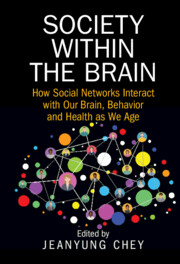Book contents
- Society within the Brain
- Society within the Brain
- Copyright page
- Dedication
- Contents
- Figures
- Tables
- Contributors
- Preface
- Introduction
- Part I Approaches to Society within the Brain
- Part II Society Interacting with Brain, Cognition, and Health in Late Life
- Chapter 5 The Life Course Approach to Cognitive Aging and Dementia
- Chapter 6 Enriched Social Connectedness and Brain Function
- Chapter 7 Psychoneuroimmunology Linking Social Isolation with Cognitive Aging
- Chapter 8 Loneliness and Psychological Health in Late Life
- Part III An Individual’s Cognitive Aging with Others: Key Findings, Issues, and Implications
- Index
- References
Chapter 7 - Psychoneuroimmunology Linking Social Isolation with Cognitive Aging
from Part II - Society Interacting with Brain, Cognition, and Health in Late Life
Published online by Cambridge University Press: 28 September 2023
- Society within the Brain
- Society within the Brain
- Copyright page
- Dedication
- Contents
- Figures
- Tables
- Contributors
- Preface
- Introduction
- Part I Approaches to Society within the Brain
- Part II Society Interacting with Brain, Cognition, and Health in Late Life
- Chapter 5 The Life Course Approach to Cognitive Aging and Dementia
- Chapter 6 Enriched Social Connectedness and Brain Function
- Chapter 7 Psychoneuroimmunology Linking Social Isolation with Cognitive Aging
- Chapter 8 Loneliness and Psychological Health in Late Life
- Part III An Individual’s Cognitive Aging with Others: Key Findings, Issues, and Implications
- Index
- References
Summary
Being an active part of a group or society (i.e., social integration) has been recognized as an important factor in promoting health and well-being in later life. With increasing attention on how social integration can lower morbidity and all-cause mortality in later life, recent studies point to immune response as a candidate link between social integration and physiological mechanisms. Given that physical aging is accompanied by elevated levels of systemic pro-inflammatory markers, such as interleukin-6 and C-reactive protein, social relationships emerge as a factor that can counteract aging processes associated with systemic inflammations. This chapter reviews how the increased inflammatory response (i.e., inflammageing) in late life may facilitate cognitive decline. Moreover, it focuses on how social integration or support plays protective roles in systemic inflammation functions. Finally, it reviews recent findings from health psychology regarding psychological factors, such as purpose in life and alteration of gut microbiome, that moderate the age-related risk factors for maladaptive immune function.
Keywords
- Type
- Chapter
- Information
- Society within the BrainHow Social Networks Interact with Our Brain, Behavior and Health as We Age, pp. 162 - 174Publisher: Cambridge University PressPrint publication year: 2023



